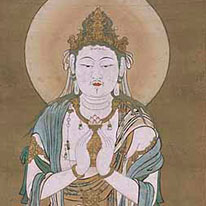Past Exhibitions
- Twelve Devas Screens and the World of Esoteric Buddhist Rituals
- January 2, 2020 - February 16, 2020
The Twelve Devas are originally Hindu gods of the twelve directions in Esoteric Buddhism, including the four quarters and four semi-quarters, up and down, and the sun and moon. They were thought to protect a ritual space from all twelve directions. The screens on display here, which feature these guardian gods, were used in Esoteric Buddhist initiation rituals, or kanjō (Sanskrit: abhiṣeka) in Japan. Originally, abhiṣeka was part of the ancient Indian royal consecration rite, in which water would be poured on the head of the monarch during the accession ceremony. In Japan, the kanjō ritual was adopted as a Buddhist rite of passage, in which the practitioner would be purified by sprinkling water onto him as a confirmation of his initiation into the Esoteric teachings. The inclusion of the Twelve Devas into the rite, however, is considered to be a purely Japanese development. It is only from the 12th century onward that deities came to be depicted in pairs of six-panel folding screens. With this, the way they were portrayed also changed. Originally seated on pedestals, they newly assumed a standing posture to be adapted to the folding screen format.












